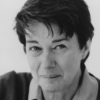Bridget Riley

Bridget Riley
Bridget Louise Riley CH CBEis an English painter who is one of the foremost exponents of Op art. She currently lives and works in London, Cornwall and the Vaucluse in France...
NationalityBritish
ProfessionPainter
Date of Birth24 April 1931
artist personality decision
It seems the deeper, truer personality of the artist only emerges in the making of decisions... in refusing and accepting, changing and revising.
opening-up space littles
In my earlier paintings, I wanted the space between the picture plane and the spectator to be active. It was in that space, paradoxically, the painting 'took place.' Then, little by little, and to some extent deliberately, I made it go the other way, opening up an interior space... so that there was a layered, shallow depth.
used tension sensations
I used to build up to sensation, accumulating tension until it released a perceptual experience
focus attention veils
Painters have always needed a sort of veil upon which they can focus their attention. It's as though the more fully the consciousness is absorbed, the greater the freedom of the spirit behind
moving eye looks
The eye can travel over the surface in a way parallel to the way it moves over nature. It should feel caressed and soothed, experience frictions and ruptures, glide and drift. One moment, there will be nothing to look at and the next second the canvas seems to refill, to be crowded with visual events.
moving eye mind
It is important that the painting can be inhabited, so that the mind's eye, or the eye's mind, can move about it credibly.
space focus painting
In general, my paintings are multifocal. You can't call it unfocused space, but not being fixed to a single focus is very much of our time.
failure artist doe
An artist's failures are as valuable as his successes: by misjudging one thing he conforms something else, even if at the time he does not know what that something else is.
spiritual thinking painting
Painting is, I think, inevitably an archaic activity and one that depends on spiritual values.
loss thinking christianity
I think this lack of a center has something to do with the loss of certainties that Christianity had to offer
artist mixtures conflict
An artist's early work is inevitably made up of a mixture of tendencies and interests, some of which are compatible and some of which are in conflict
term
I work with nature, although in completely new terms.
squares giving essentials
I couldn’t get near what I wanted through seeing, recognizing and recreating, so I stood the problem on its head. I started studying squares, rectangles, triangles and the sensations they give rise to It is untrue that my work depends on any literary impulse or has any illustrative intention. The marks on the canvas are sole and essential agents in a series of relationships which form the structure of the painting.
time
His failures are as valuable as his successes: by misjudging one thing he conforms something else, even if at the time he does not know what that something else is.